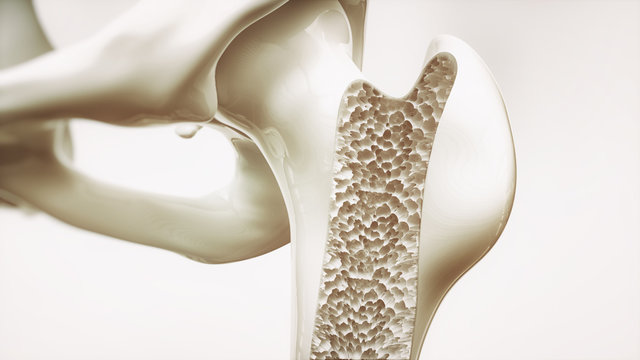Osteoporosis is a medical condition characterized by the weakening of bones, making them fragile and more susceptible to fractures. This “silent disease” often progresses without noticeable symptoms until a fracture occurs. Bone health is a critical component of overall health, particularly as we age. This article delves into the nature of osteoporosis, its causes, symptoms, prevention, treatment, and the latest research in the field.
What is Osteoporosis?
Osteoporosis is a condition in which bones become less dense and more prone to fractures. It differs from osteopenia, a less severe form of bone loss that can precede osteoporosis. The condition affects millions worldwide, particularly older adults and postmenopausal women. According to the International Osteoporosis Foundation, one in three women and one in five men over the age of 50 will experience osteoporotic fractures in their lifetime.
Causes and Risk Factors
Several factors contribute to the development of osteoporosis:
- Genetic Factors: Family history plays a significant role. If your parents or grandparents had osteoporosis or fractures, you might be at a higher risk.
- Hormonal Changes: Hormones, particularly estrogen in women, help maintain bone density. Menopause, which leads to a drop in estrogen levels, is a significant risk factor for developing osteoporosis.
- Nutritional Deficiencies: Adequate intake of calcium and vitamin D is crucial for bone health. Deficiencies in these nutrients can lead to bone loss and increased fracture risk.
- Lifestyle Factors: Smoking and excessive alcohol consumption negatively impact bone health. These habits can interfere with the body’s ability to absorb calcium and other vital nutrients.
- Medical Conditions and Medications: Certain diseases, such as rheumatoid arthritis and conditions requiring long-term use of corticosteroids, can increase the risk of osteoporosis.
Symptoms and Diagnosis
Osteoporosis is often called the “silent thief” because it can progress without any symptoms until a bone fractures. Common symptoms include:
- Fractures: Particularly in the hip, spine, and wrist, often occurring with minimal trauma.
- Back Pain: Due to fractured or collapsed vertebrae.
- Loss of Height: A result of spinal fractures.
- Stooped Posture: Caused by spinal bone fractures.
Diagnosis typically involves bone density tests, most commonly the Dual-Energy X-ray Absorptiometry (DEXA) scan. This test measures bone mineral density and compares it to a standard reference. Other diagnostic tools include X-rays and blood tests to rule out other conditions that may cause bone loss.
Impact of Osteoporosis
The impact of osteoporosis extends beyond physical health, affecting emotional and economic aspects of life:
- Physical Impact: Fractures can lead to chronic pain, disability, and loss of independence, significantly affecting the quality of life.
- Emotional and Psychological Effects: The fear of falling and sustaining fractures can lead to anxiety and depression.
- Economic Burden: The cost of treating osteoporotic fractures is substantial, including medical expenses and long-term care needs.
Prevention Strategies
Preventing osteoporosis involves a combination of lifestyle changes and proactive measures:
- Diet and Nutrition: Ensure an adequate intake of calcium and vitamin D. Foods rich in calcium include dairy products, leafy green vegetables, and fortified foods. Vitamin D can be obtained from sunlight exposure and foods like fatty fish and fortified dairy products.
- Exercise and Physical Activity: Regular weight-bearing exercises such as walking, jogging, and resistance training help maintain bone density. Activities that improve balance and coordination, such as yoga and tai chi, can reduce the risk of falls.
- Lifestyle Changes: Quitting smoking and reducing alcohol intake are crucial steps. Both habits can significantly weaken bones over time.
- Fall Prevention Tips: Ensure a safe living environment by removing tripping hazards, using assistive devices if necessary, and wearing appropriate footwear.
Treatment Options
If osteoporosis is diagnosed, several treatment options are available:
- Medications: Various drugs can help prevent and treat osteoporosis:
- Bisphosphonates: These are the most commonly prescribed drugs that slow bone loss and reduce fracture risk.
- Hormone Replacement Therapy: Effective for maintaining bone density in postmenopausal women, though not without risks.
- Other Medications: Such as selective estrogen receptor modulators (SERMs) and parathyroid hormone-related protein analogs.
- Lifestyle Modifications: Maintaining a healthy diet rich in calcium and vitamin D, and engaging in regular physical activity.
- Alternative and Complementary Therapies: Supplements like calcium and vitamin D can be beneficial. Physical therapy may also be recommended to strengthen muscles and improve balance.
- Surgical Options: In severe cases where fractures occur, surgical interventions like vertebroplasty or hip replacement might be necessary.
Living with Osteoporosis
Managing osteoporosis requires a multifaceted approach:
- Coping Strategies: Understanding the condition and its limitations helps in adapting daily activities to reduce fracture risk.
- Support Systems and Resources: Engaging with support groups, educational programs, and healthcare providers can provide essential assistance.
- Regular Medical Check-Ups: Monitoring bone density and overall health through regular check-ups is crucial for managing osteoporosis effectively.
Research and Future Directions
Ongoing research continues to improve our understanding and treatment of osteoporosis:
- Current Research Trends: Investigations into genetic factors, the role of the gut microbiome in bone health, and the development of new medications are ongoing.
- Advances in Treatment and Prevention: Innovations in drug therapy, such as biologics that target specific pathways involved in bone remodeling, show promise.
- Potential Future Therapies: Research into stem cell therapy and gene editing offers hope for more effective treatments in the future.
Conclusion
Osteoporosis is a significant health concern that can severely impact quality of life. Awareness and early intervention are crucial in managing and preventing this condition. By understanding the risk factors, symptoms, and treatment options, individuals can take proactive steps to maintain bone health and reduce the risk of fractures. Consulting with healthcare providers and making informed lifestyle choices are vital components in the fight against osteoporosis.
